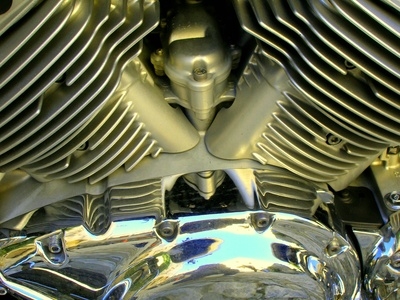
Carburetors deliver a combination of air and fuel to internal combustion engines. These components use intake and exhaust valves to divide and transport the air-fuel mixture into the engine. The Rochester carburetor came about in 1965, when General Motors (GM) began using them in its vehicles with eight-cylinder engines; GM continued to install the carburetors in its vehicles for nearly 20 years. As of 2011, you can purchase an aftermarket Rochester carburetor, also called a Quadrajet.
The Rochester B carburetor had a float level of 1.28 inches and a float drop of 1.75 inches. The idle vented at 0.05 inches with the engine stopped in an idle position and the choke open. The Rochester B had a bowl vent of 3 internal and 1 external idle, while the 292 version had a bowl vent of 2 internal and 1 external idle. The throttle bore measured 1.563 inches for the Rochester B, but 1.75 inches for the 292 version. The main venturi for the 230 Economy version measured 1.063 inches, the main venturi for the 230 P and 230 version measured 1.594 inches and the main venturi for the 292 version measured 1.625 inches. The small venturi for all Rochester B versions measured 0.594 inches. The Rochester B pump discharge jet measured 0.031 inches, while the 292 version's measured 0.035 inches. The idle speed jet measured 0.067 inches, while the 230 Economy version's measured 0.057 inches.
The Rochester 2G had a float level of 1.359 inches and a float drop of 1.906 inches. It had a bowl vent of 1 inside. The throttle bore measured 1.438 inches, while the pump discharge measured 0.026 inches. It had main venturi of 1.094 inches and a small venturi of 0.125 inches. The main metering jet measured 0.053 to 0.054 inches.
The Rochester 4G 348 had a primary float level of 1.625 inches and a secondary float level of 1.688 inches. It had a float drop of 2.25 inches and a bowl vent of 2 inside. The throttle bore measured 0.438 inches, and the primary discharge jet measured 0.026 inches. It had a primary main venturi of 1.125 inches and a secondary main venturi of 1.25 inches. The small venturi measured 0.25 inches. The 348 version's primary main metering jet measured 0/055 inches, while the secondary main metering jet measured 0.069 inches. The 409 version's main metering jet measured 0.054 inches, and the secondary main metering jet measured 0.067 inches.
The idle speed jet for the Rochester B measured 0.067 inches, while the 230 economy version measured 0.057 inches. The Rochester 2G 283 version's idle tube measured 0.028 inches, the 327 version's measured 0.031 inches and the 348 version's measured 0.037 inches. The Rochester 4G carburetor's primary idle tube measured 0.027 to 0.028 inches, and the secondary idle tube measured 0.040 inches.